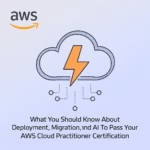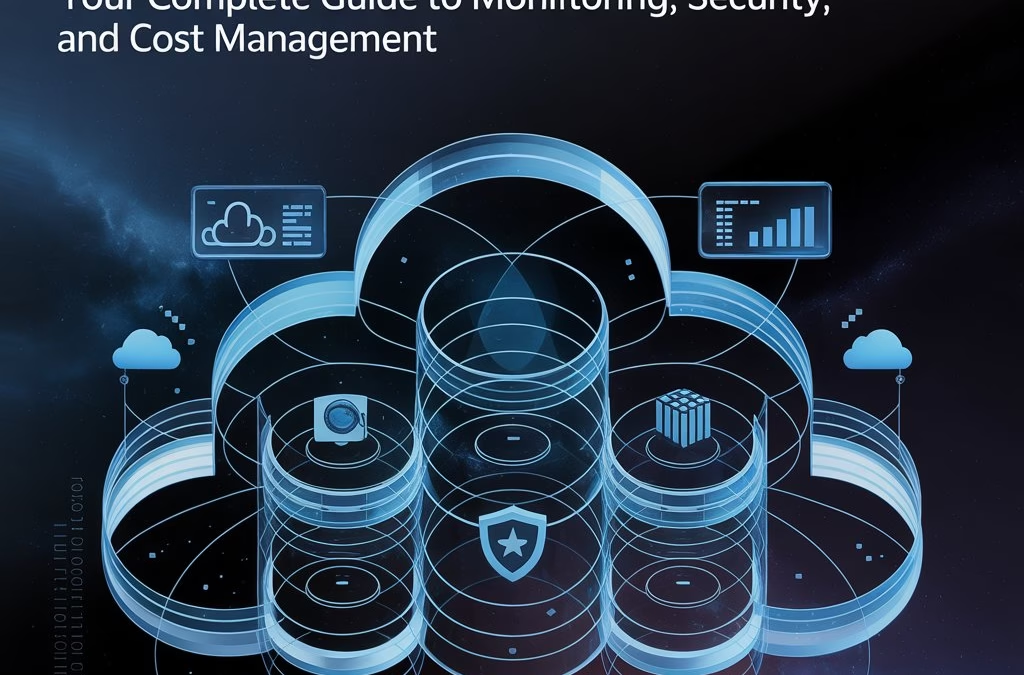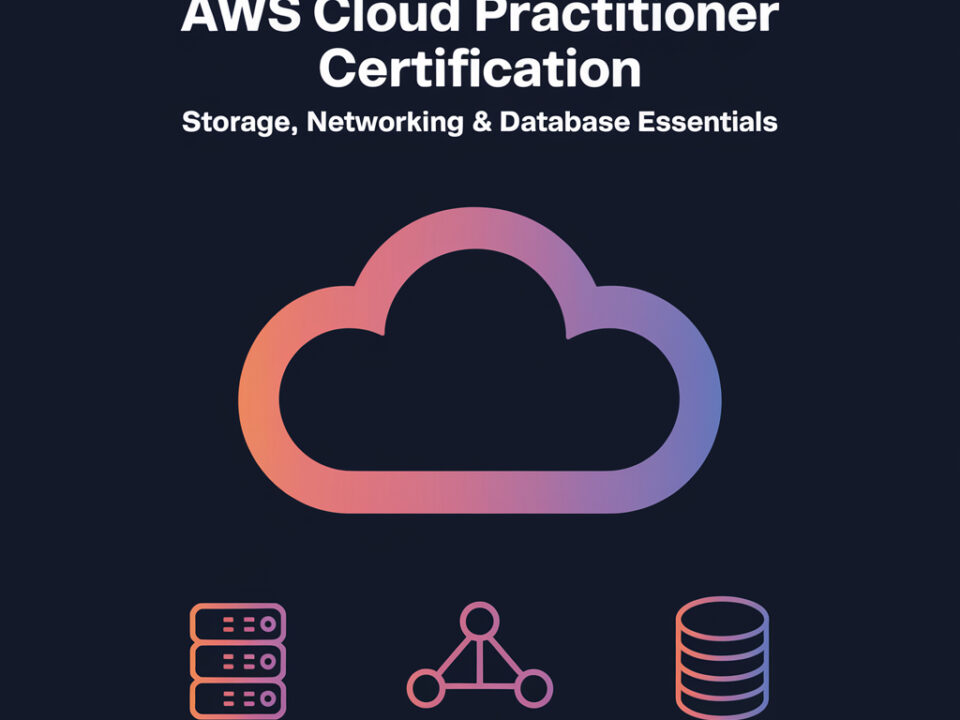
What You Should Know About Deployment, Migration, and AI to Pass Your AWS Cloud Practitioner Certification
20/04/2025Preparing for the AWS Cloud Practitioner Exam? In this comprehensive guide, we’ll explore key concepts in Monitoring, Security, and Pricing to boost your chances of success. Let’s dive in!
1. Monitoring
Effective monitoring in AWS relies heavily on metrics generated by AWS services. These metrics track workload health, configure alarms, and proactively address issues, such as monitoring CPU utilization in EC2 instances or tracking AWS Lambda invocations.
1.1 AWS CloudWatch
AWS CloudWatch tracks AWS resources and applications. It gathers metrics, manages logs, displays dashboards, and sets alarms based on thresholds, offering deep visibility into your AWS environment.
1.2 AWS CloudTrail
AWS CloudTrail audits and logs actions within your AWS account. It provides detailed records of API activities, enhancing accountability and compliance.
1.3 Managing Multiple AWS Resources
Efficiently managing AWS resources is crucial. Tags and AWS Systems Manager simplify resource organization and automation.
1.3.1 Tags
Tags (key-value pairs like Environment: Production) organize and categorize resources, enabling easy identification and management.
1.3.2 AWS Systems Manager
AWS Systems Manager manages AWS, on-premises, and hybrid environments, automating tasks and securely storing sensitive data through Parameter Store.
1.4 AWS Health Dashboard
The AWS Health Dashboard provides real-time insights into AWS service outages and performance issues, enabling rapid responses.
1.5 AWS Trusted Advisor
AWS Trusted Advisor recommends improvements based on best practices, enhancing security, reliability, performance, and cost-efficiency.
1.6 AWS Config
AWS Config ensures resource compliance by alerting you when configurations deviate from set standards.
1.7 AWS Audit Manager
AWS Audit Manager streamlines compliance audits by automating data collection and organization.
1.8 AWS Well-Architected Tool
This tool evaluates your architecture against AWS best practices, offering customized optimization recommendations.
1.9 Amazon Connect
A scalable, cloud-based contact center solution for remote customer service operations.
1.10 Amazon WorkSpaces
Secure managed virtual desktops enabling remote access from anywhere.
1.11 Amazon AppStream
Streams traditional desktop applications as SaaS through web browsers, simplifying infrastructure management.
2. Security
Cloud security in AWS revolves around shared responsibility between AWS and customers.
2.1 Shared Responsibility Model
AWS manages infrastructure security, while customers secure their data, applications, network configurations, IAM, and encryption.
Customer Responsibilities:
- Data Protection: Encryption, access controls, backups, and retention policies.
- Applications & Platforms: Secure configurations and external integrations.
- IAM: Manage user permissions, ensuring least privilege.
- Networks & OS: Secure VPCs, patch operating systems, configure firewalls.
- Encryption: Handle encryption at rest and in transit.
- Managed Services: Understand and secure responsibilities when using managed services.
2.2 Principle of Least Privilege
Grant minimal required permissions using IAM to ensure optimal security.
2.3 Identity and Access Management (IAM)
IAM manages user and resource access, defining permissions via JSON policies and roles, supported by tools like Access Analyzer and Policy Simulator.
2.4 Keeping Secrets Safe
Secure sensitive data with encryption (in transit and at rest) and AWS secret management tools like Parameter Store and Secrets Manager.
2.5 Network Security Services
- Network ACLs: Stateless subnet-level filtering.
- Security Groups: Stateful instance-level control.
- AWS Network Firewall: Deep traffic inspection.
- AWS WAF: Protects web applications.
- AWS Shield: Mitigates DDoS attacks.
- AWS Firewall Manager: Centralized security management.
2.6 AWS Security Hub
Consolidates security findings from multiple services for centralized monitoring.
2.7 AWS Trusted Advisor
Real-time security and best practice recommendations.
2.8 Amazon GuardDuty
Detects threats using machine learning on log data.
2.9 AWS Detective
Facilitates security incident investigation.
2.10 Amazon Inspector
Automated vulnerability scanning and compliance checks.
2.11 Improving Security Skills
Security is an ongoing process. Utilize AWS resources like the AWS Security Blog and AWS Marketplace for continuous improvement.
2.12 Governing Multiple AWS Accounts
Leverage AWS Organizations, Control Tower, and Security Hub for centralized, secure multi-account management.
2.13 Compliance on AWS
Utilize AWS Artifact, Audit Manager, and STS to meet industry compliance requirements effectively.
3. Costs, Billing, and Support
Cloud cost management includes understanding Total Cost of Ownership (TCO) and optimizing cloud usage compared to traditional data centers.
3.1 Total Cost of Ownership (TCO)
Cloud computing eliminates large upfront investments, reducing operational burdens and offering flexible, pay-as-you-go pricing.
3.2 Optimizing Compute Costs
Strategies include Auto Scaling, Right-Sizing, Reserved Instances, Spot Instances, and Compute Optimizer to reduce expenses.
3.3 AWS S3 Storage Costs
Choose appropriate S3 storage classes (Standard, Standard-IA, Glacier) based on access frequency and latency needs.
3.4 AWS Data Transfer Costs
Data transfer costs vary by destination—optimize to minimize expenses by understanding these differences.
3.5 Monitoring AWS Costs
Utilize AWS Pricing Calculator, Budgets, Cost Explorer, and CUR for detailed cost management.
3.6 Managing Multi-Account Costs
AWS Organizations and Billing Conductor provide centralized cost control and visibility across multiple accounts.
3.7 AWS Support Plans
Choose from Basic (free), Developer, Business, Enterprise On-Ramp, or Enterprise based on your support requirements.
3.8 Additional AWS Support
Explore AWS IQ, Managed Services, Professional Services, and AWS Activate for specialized assistance.
Conclusion
Successfully preparing for the AWS Cloud Practitioner Exam means mastering critical aspects of Monitoring, Security, and Pricing. Leverage the detailed AWS services and strategies outlined in this guide to solidify your understanding and proficiency. Consistent review and hands-on practice will ensure your readiness and confidence to excel in the exam and your cloud career.




